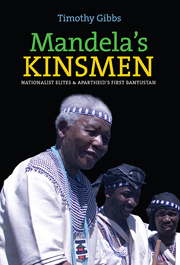Book contents
- Frontmatter
- Contents
- List of Maps and Figures
- Acknowledgements
- List of Abbreviations
- Introduction: Mandela' Kinsmen
- 1 Education, Monarchy & Nationalism
- 2 The First Bantustan, 1954–1963
- 3 The Second Peasants' Revolt, Mpondoland 1960–1980
- 4 The Old Mission Schools, 1963–1980
- 5 The Comrade-King, Bantustan Politics 1964–1980
- 6 Chris Hani's Guerrillas, 1974–1987
- 7 The Apartheid Endgame, 1987–1996
- 8 The New South Africa & Transkei's Collapse, 1990 onwards
- Conclusion: African Nationalism & its Fragments
- Bibliography
- Index
4 - The Old Mission Schools, 1963–1980
Published online by Cambridge University Press: 05 April 2014
- Frontmatter
- Contents
- List of Maps and Figures
- Acknowledgements
- List of Abbreviations
- Introduction: Mandela' Kinsmen
- 1 Education, Monarchy & Nationalism
- 2 The First Bantustan, 1954–1963
- 3 The Second Peasants' Revolt, Mpondoland 1960–1980
- 4 The Old Mission Schools, 1963–1980
- 5 The Comrade-King, Bantustan Politics 1964–1980
- 6 Chris Hani's Guerrillas, 1974–1987
- 7 The Apartheid Endgame, 1987–1996
- 8 The New South Africa & Transkei's Collapse, 1990 onwards
- Conclusion: African Nationalism & its Fragments
- Bibliography
- Index
Summary
The Children of Soweto and Transkei's elite
Above all, it was the mission schools dotted across the Native Reserves that shaped the African elite during the middle decades of the 20th century. The story is most easily told in the figures. In 1940, the year after Nelson Mandela left Healdtown College, there were only 5,800 African pupils in secondary school in the entire country. Two decades later, when Thabo Mbeki sat his school exams at St Johns College at Umtata, secondary schooling remained an elite concern. In 1960 only 4% of African teenagers attended a secondary school; even fewer graduated. That year, there were 47,000 African pupils in secondary school, of which just 957 sat the Senior Certificate exam that marked the end of school education. Consequently, African political elites were linked together by close-knit kinship, friendship and rivalries.
In one sense, apartheid marked a generational watershed. During the Bantustan era the pre-eminence of the tiny network of mission schools – mainly based in the Eastern Cape – was largely overshadowed by the ‘massification’ of South African society. The centre of gravity in youth politics largely shifted from the old mission colleges to the burgeoning township schools. By 1980 one-third of African teenagers attended secondary school. The number taking the school leaving exam nationwide climbed from 957 in 1960 to 774,000 in 1980. (This 800-fold increase far outstripped the demographic growth rates, with the African population increasing from 11 million to 21 million in the same period.) Transkei's school enrolments followed national trends: from 1964 to 1980, secondary school pupil numbers grew from 9,500 to 151,000, whilst population numbers doubled.
- Type
- Chapter
- Information
- Mandela's KinsmenNationalist Elites and Apartheid's First Bantustan, pp. 70 - 90Publisher: Boydell & BrewerPrint publication year: 2014



